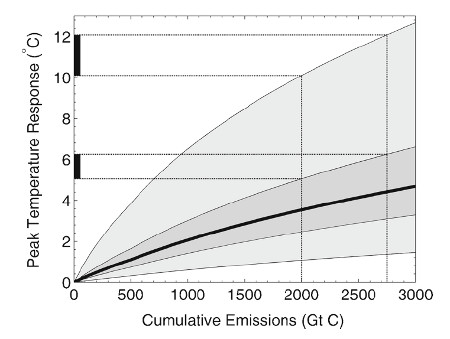A new two-part study published in Climatic Change by a team of scientists led by Stephan Lewandowsky examines mathematically what happens to the risks posed by climate change when the scientific uncertainty increases. Part 1 of the study explores two important points.
First, the probable range of climate sensitivity to the increased greenhouse effect isn't symmetrical. Instead, based on the available evidence and research, it's more likely that we'll see a large amount of global warming than a small amount in response to rising carbon emissions. By itself, this means that more climate uncertainty translates into an even bigger risk of painful consequences than relatively benign consequences. More uncertainty means a slightly better chance of the low warming outcomes, but it also means an even bigger chance of the high warming outcomes, because the scientific data have a harder time ruling those out.
The second critical point is that economic models agree that once we reach a certain tipping point, the costs of climate damage increase at an accelerating rate. The models don't agree on exactly where that tipping point lies, but they do agree on the shape of the curve and the acceleration of the climate damage costs once we pass that tipping point (even the 'skeptics' agree on this).
Lewandowsky's team combined the shape of the curve showing the probable values of the Earth's climate sensitivity with the shape of climate economic costs curve, and came to an inescapable conclusion: more climate uncertainty means the expected damages from climate change are higher.
In fact, because both curves are more heavily weighted on their high sides (greater probability of high climate sensitivity than low, and climate damage costs accelerating with more warming), this conclusion holds true even if the shape of one of the curves changes. For example, even if climate sensitivity is equally likely to be low as high, the accelerating nature of climate damage costs with more warming would still mean that greater climate uncertainty translates into more climate damages.
Part 2 of the study also shows that greater climate science uncertainty means we're more likely to blow past the internationally accepted 'danger limit' of 2°C global surface warming. To meet that target we have a certain carbon emissions 'budget,' but there's also uncertainty associated with the exact size of that budget. If the total budget turns out to be less than the emissions we have already pumped into the atmosphere, then mitigation has already failed to keep temperatures below the 'danger limit.'
With more climate uncertainty, the range of possible carbon budget sizes becomes wider. The shape of this curve also means that the average estimated carbon budget value increases. This means that with more uncertainty we're more likely to think the budget is larger than it actually is, and hence we're more likely to miss our target and cause dangerous global warming.



